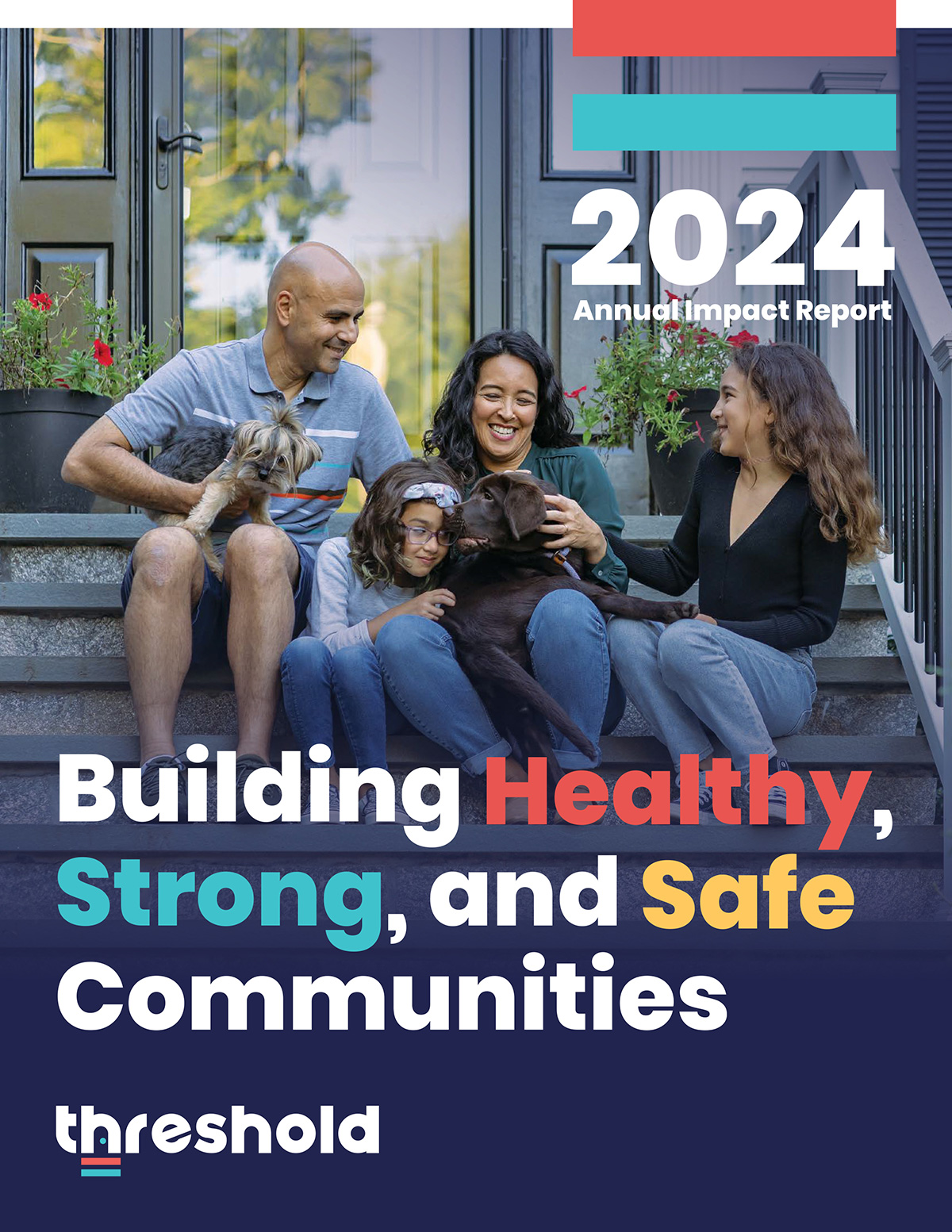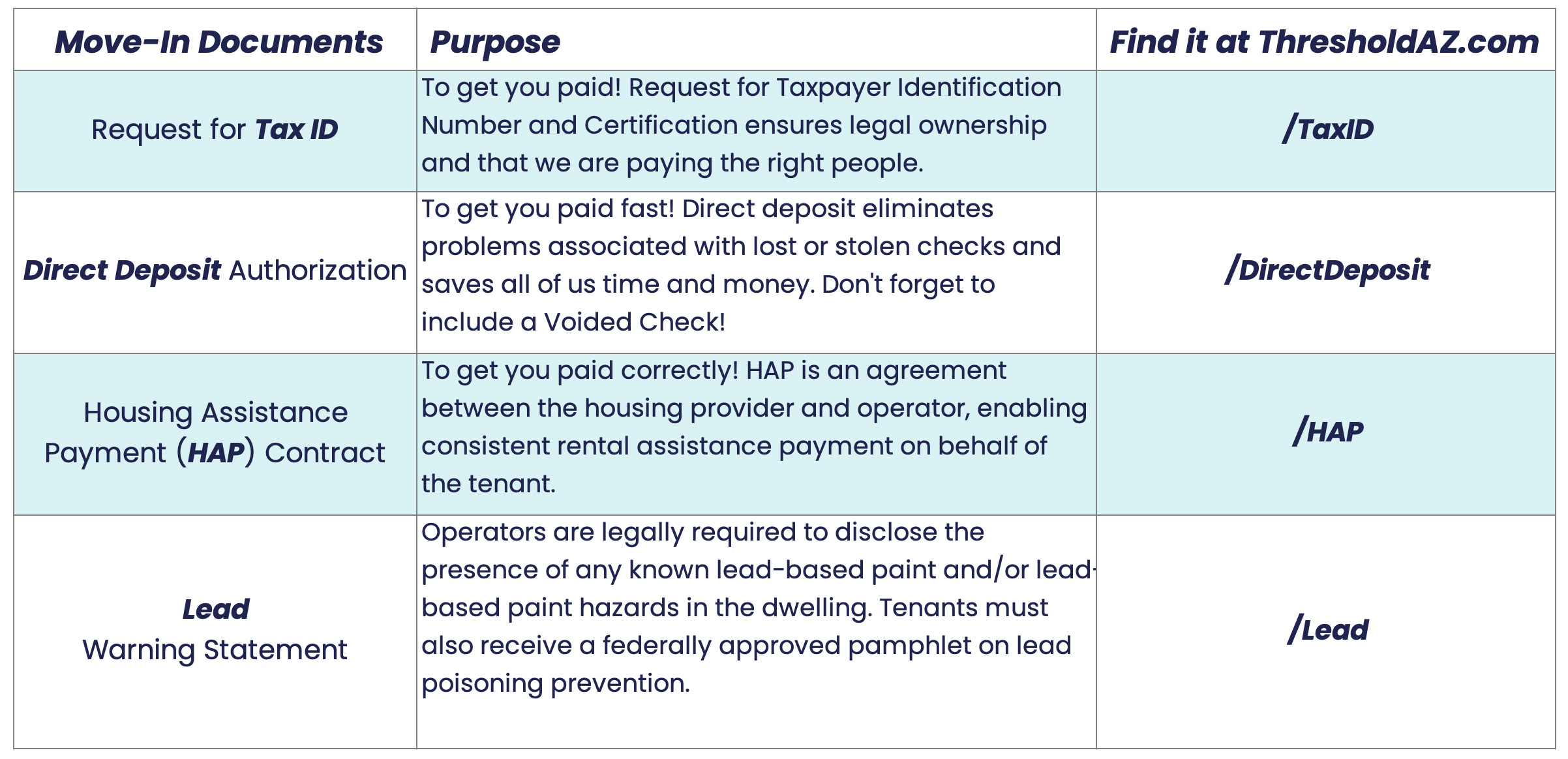Efficient move-ins are a key component of successful property management. They not only enhance the overall experience for tenants but also offer significant benefits for property owners and managers. A streamlined move-in process can minimize vacancies, reduce turnover costs, and foster positive tenant relationships. This ultimately leads to better property performance and increased profitability.
At Threshold, we recognize the transformative power of faster move-in times for property owners and operators, but also for the ability of our community to address the pressing issue of homelessness. By reducing the time individuals spend in temporary shelters or on the streets, we can provide immediate shelter and stability, significantly improving their overall well-being.
Let’s further explore the advantages of faster move-in times, how it helps alleviate the homeless housing crisis and presents several numerous benefits to property owners and managers.

One of the most immediate and impactful benefits of faster move-in times is the rapid reduction in homelessness.
Immediate Shelter and Crisis Management
By quickly transitioning individuals and families from temporary shelters or the streets into permanent housing, we can drastically reduce the number of people without a stable home. This swift action is key in alleviating the pressures on emergency shelters and temporary housing facilities, allowing them to serve more individuals in need. The quicker people are moved into permanent homes, the sooner these resources become available to help the next household in line. This creates a more efficient and responsive support system.
“While our ultimate goal is to get our neighbors experiencing homelessness into permanent housing as fast as possible, connecting vulnerable people to safe shelter is the immediate priority,” said Greg Faust, Regional Outreach Manager for Keys to Change (formerly Human Services Campus). “Our primary goal is to get our neighbors into permanent housing as quickly as possible. However, with the unique life-threatening climate in Arizona, having immediate access to emergency shelter can be a critical step for many, where they can receive basic necessities in a safe, cool environment.”
The positive effects of immediate shelter extend beyond merely providing a roof over someone’s head. Regular access to on-site supportive services and connection to longer-term rental assistance programs offering move-in assistance, such as rapid rehousing and permanent supportive housing, significantly reduces the time individuals spend in unsafe and unhealthy environments, which can have profound implications for their physical and mental health. Homelessness often exposes people to dangerous conditions, increasing their vulnerability to violence, illness, and stress. By moving individuals into housing quickly, we can prevent many of these adverse outcomes, enhancing their overall well-being and reducing the trauma associated with prolonged periods of homelessness.
Security and Stability for Residents
Faster move-in times do more than just provide immediate shelter. They offer the security and stability that individuals need to begin addressing underlying issues that contributed to their homelessness. The instability of being unhoused can lead to significant mental health challenges and exacerbate existing conditions. Many individuals resort to coping mechanisms like substance use, which further complicates their path to stability. By securing housing quickly, we provide individuals with a safe environment where they can start to focus on their mental health and receive the support they need to overcome these challenges.
Stability is especially important for families with children. The trauma and stress associated with homelessness can have a profound impact on children. It can affect their behavior, academic performance, and overall development. Younger children may struggle to process and cope with instability, leading to increased behavioral issues both at home and in school. When families are moved into permanent housing more quickly, children benefit from a consistent environment where they can thrive. This not only improves their immediate well-being but also sets a foundation for better long-term outcomes.
For parents, a faster move-in means less time spent navigating the uncertainties and dangers of homelessness. With the security of housing, they can better focus on their responsibilities and work toward improving their family’s situation. They have more energy and resources to dedicate to finding employment, accessing healthcare, and supporting their children’s needs and education. This allows families to rebuild their lives with a sense of normalcy, which is essential for breaking the cycle of homelessness.

Faster move-in times offer profound benefits for individuals by providing a permanent living situation sooner, which is pivotal for their overall recovery and reintegration into society.
Improved Outcomes
A secure place to live is the cornerstone upon which individuals can begin to rebuild their lives. Once housed, people can more easily access essential services such as healthcare, job training, and educational opportunities. These services are crucial for improving their quality of life and fostering long-term independence.
The link between housing and educational attainment is also significant. For children, having a consistent home environment is vital for their academic success. It allows them to attend school regularly, focus on their studies, and participate in extracurricular activities. These things help contribute to better educational outcomes. For adults, reliable housing provides the foundation needed to pursue further education or vocational training, which can enhance their employment prospects and earning potential. This allows individuals to plan for the future, setting and achieving personal and professional goals that would otherwise be unattainable in a state of homelessness.
Additionally, secure housing facilitates job readiness and employment opportunities. Without the constant worry of where they will sleep or how they will stay safe, individuals can concentrate on securing and maintaining employment. They can develop a routine, keep consistent work hours, and have a reliable address for job applications. This is key for gaining and sustaining employment, which in turn, supports economic independence and reduces reliance on social services.
For property owners and managers, tenants who are securely housed and engaged in improving their circumstances are more likely to be reliable, long-term residents. This reduces turnover rates and the associated costs of finding and preparing units for new tenants. By supporting faster move-in times, property owners and managers not only contribute to resolving the homeless crisis but also benefit from a more consistent and dependable tenant base.
Efficient Resource Utilization
When individuals are housed swiftly, the costs associated with emergency services, transitional housing, and other temporary support mechanisms are significantly reduced. Temporary shelters and emergency services are often expensive to operate. Prolonged stays in such facilities can strain public and private resources. By shortening the time individuals spend in these temporary arrangements, we can redirect funds toward more sustainable housing solutions. This benefits both the individuals in need and the broader community.
“There’s a lot that utilization can tell us,” says Brian Petersen, CEO and President of HOM, Inc. “First, it’s about just numbers – the number of people we are serving and if we’re utilizing all the dollars. Secondly, it tells us about the efficacy of the program. If you’re not efficient in your administration of the program, if you’re not doing well in processing requests for tenancy approvals, if you’re not getting out quickly and doing inspections, if you’re not engaging landlords and giving tenants choice to be able to lease around the community, then you’re not going to get utilization. Utilization is a lag indicator. But it’s a key lag indicator that something good is going on if you’re utilization at a high percentage and throwing some red flags to you if you’re utilizing at a low percentage.”
Empty units represent lost revenue for property owners and managers. Prolonged vacancies not only result in lost rental income but also incur additional costs related to marketing the property, preparing the unit for new tenants, and administrative expenses. By streamlining the move-in process, property owners can minimize these costs and maximize their rental income. Faster move-ins lead to higher occupancy rates, ensuring that properties remain profitable and well-maintained.
For property owners and managers, participating in programs that facilitate faster move-ins can also enhance their reputation and community standing. Demonstrating a commitment to addressing homelessness and efficiently utilizing resources can attract support from local governments, non-profit organizations, and potential tenants who value socially responsible practices.
Prevention of Recidivism
Living in a stable environment allows tenants to integrate into their communities, which is essential for long-term success. Building relationships with neighbors, engaging in local activities, and feeling a sense of belonging can all contribute to a tenant’s ability to stay housed. Community support can provide both practical assistance, such as help with childcare or transportation, and emotional support, which is crucial for individuals who may have experienced significant trauma and instability. By fostering a sense of community, property owners and managers can help tenants build the social networks that are essential for sustained success.
For property owners and managers, reducing recidivism translates to more consistent and reliable tenancies. Tenants who are well-supported are less likely to break leases or fall behind on rent. This leads to lower turnover rates and more predictable rental income.
Economic Contributions
On an economic level, permanent housing enables individuals to contribute more effectively to the local economy. Once housed, people can focus on securing and maintaining employment, which increases their purchasing power and economic participation. They are more likely to spend money on local goods and services, support small businesses, and pay taxes. This economic activity stimulates local economies, creating a positive cycle of growth and prosperity that benefits all residents. Property owners and managers also benefit from a more vibrant and economically active community. Higher employment rates and economic stability can lead to more reliable rental payments and lower vacancy rates.
Consistent housing also provides a foundation for individuals to pursue personal and professional development opportunities. With a secure place to live, individuals can focus on advancing their education. They can acquire new skills and seek better job opportunities. This not only improves their own economic prospects but also contributes to a more skilled and capable community workforce. Tenants who are economically viable and engaged in self-improvement are likely to be more dependable and responsible, enhancing the overall quality of the tenancy.
Furthermore, the presence of permanently housed individuals contributes to the safety and security of neighborhoods. When people are housed, they are less likely to engage in activities that can lead to crime or social disorder. This creates a safer environment for all residents, which can enhance the appeal of the neighborhood and increase property values. Property owners and managers benefit from being part of a safer community, as it can attract more prospective tenants and reduce the costs associated with property damage or security issues.

The benefits of faster move-in times extend beyond immediate relief and long-term stability for individuals and communities. They also create a positive feedback loop that enhances trust in social services and supports policy advocacy for homelessness prevention.
Positive Feedback Loop
When people witness the effectiveness of rapid rehousing programs, their confidence in the system increases. This makes them more likely to seek help and participate in support services in the future. The increased engagement leads to better outcomes for individuals as they are more likely to access the resources they need to maintain reliable housing and improve their quality of life.
A key component of this positive feedback loop is the demonstration of success through faster move-ins. When property owners and managers see that quicker occupancies can lead to reliable tenancies and lower turnover rates, they become more inclined to support such initiatives. This support can manifest in many ways, such as participating in housing programs, advocating for related policies, or investing in properties that cater to homeless housing efforts. The tangible results from these programs can also attract additional funding and resources from both public and private sectors. This further strengthens the system and helps expand its reach.
A Win-Win Situation
As property owners and managers, you have a unique opportunity to make a significant impact by supporting and implementing faster move-in strategies. By partnering with Threshold, you can help provide housing to those in need, while also benefiting from more reliable and long-term tenancies. Visit Threshold online to learn more about our initiatives and how you can get involved. Together, we can create a more efficient, compassionate, and effective system for addressing homelessness, ultimately building stronger and more resilient communities. Your involvement is essential in making a difference and ensuring that everyone has access to stable housing.














